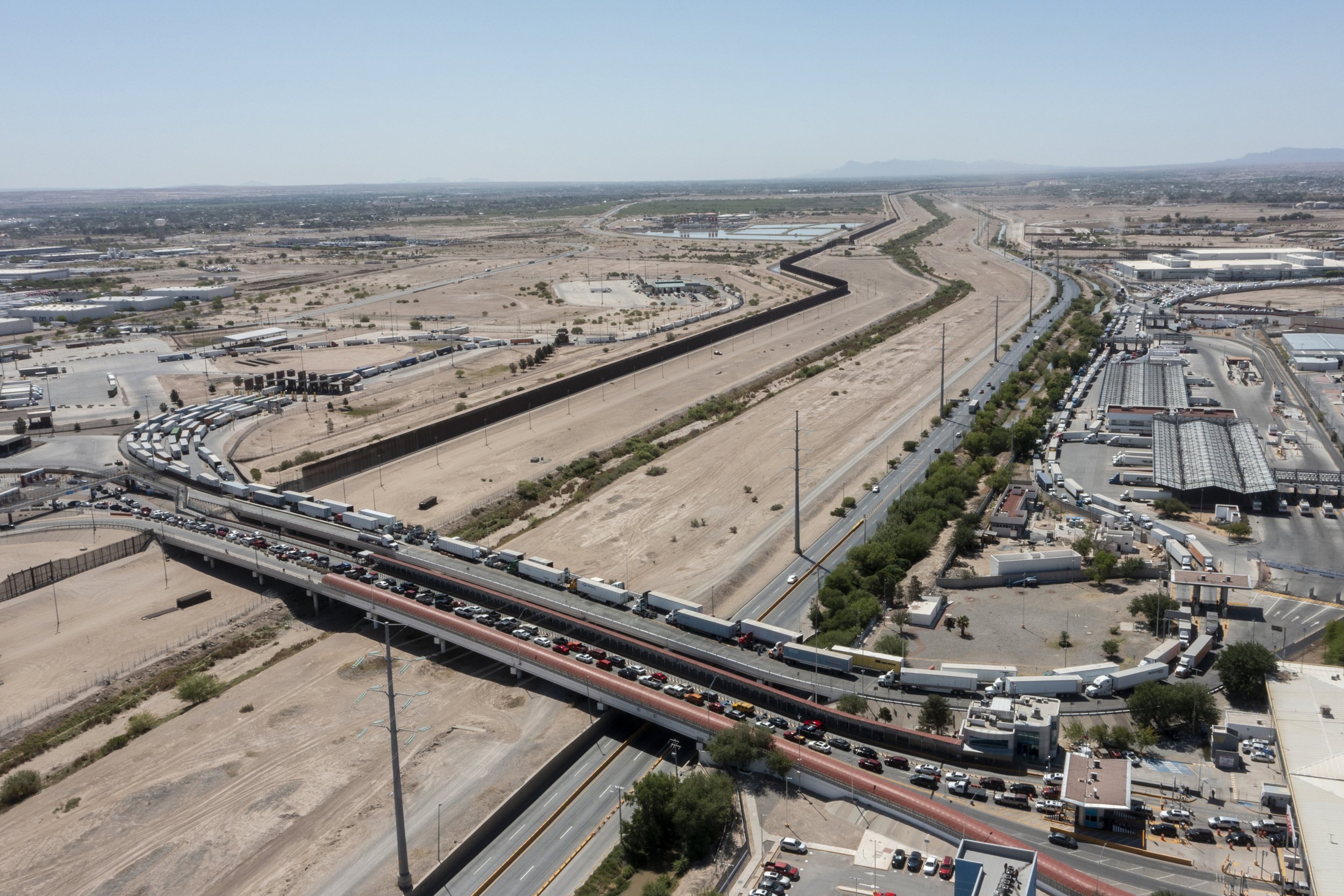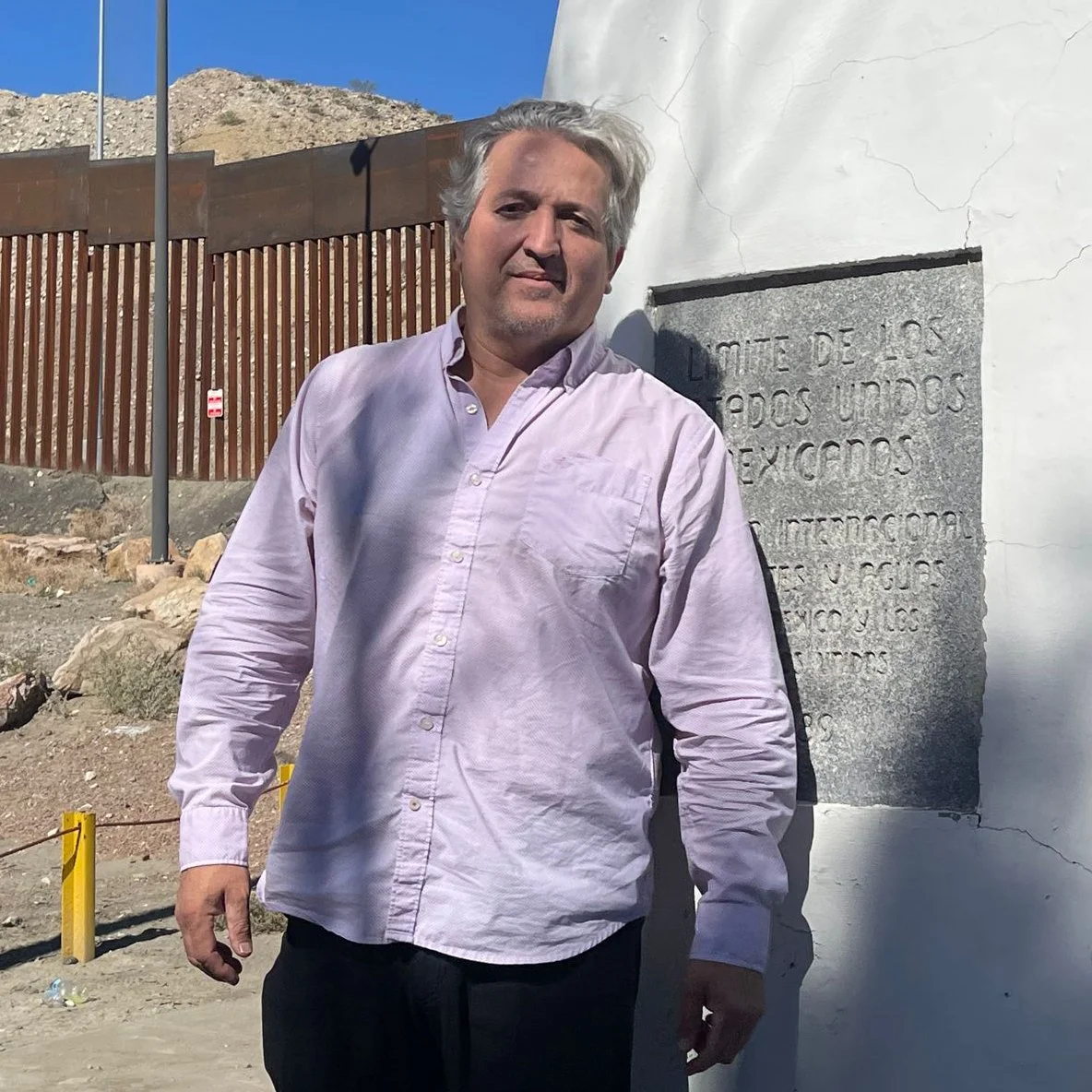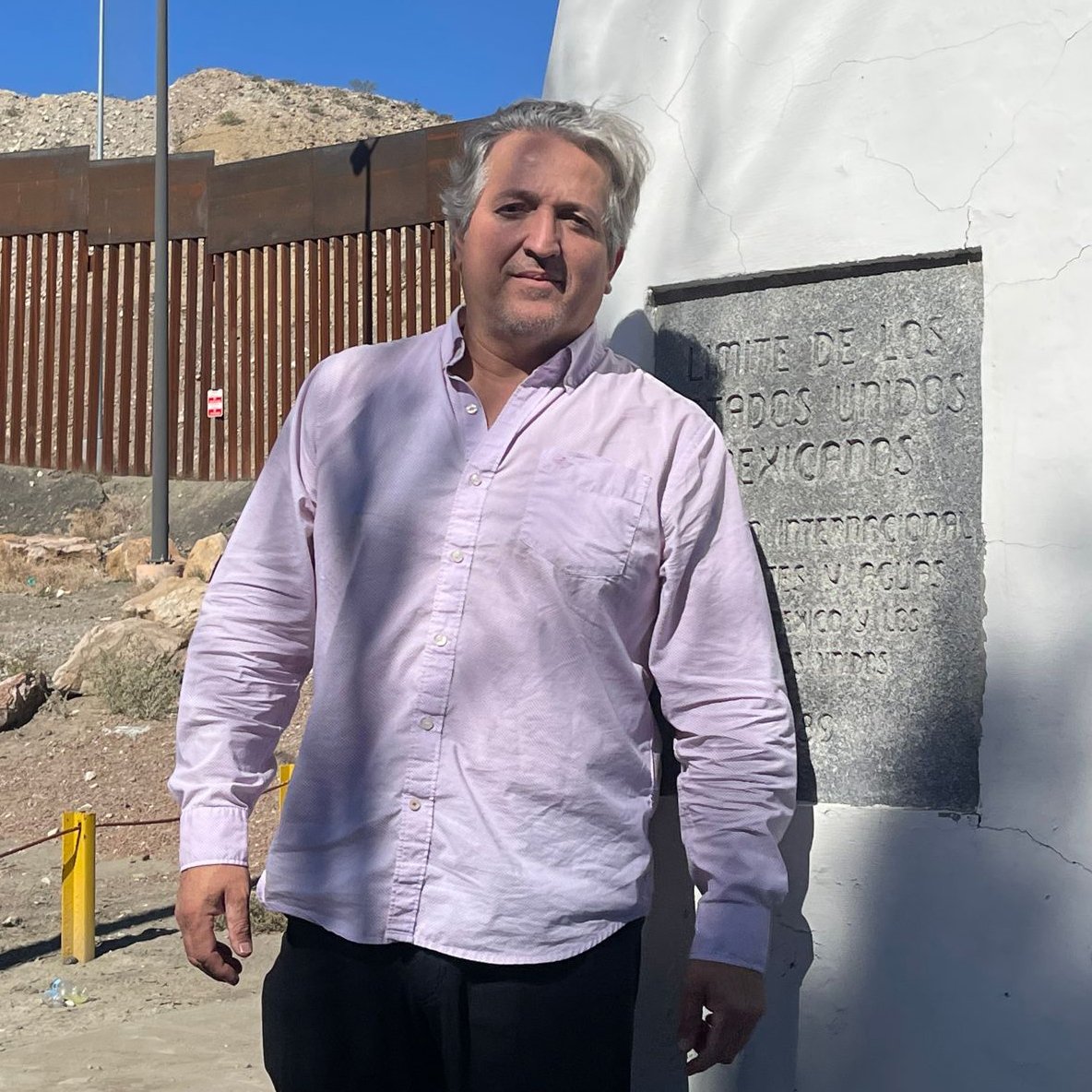Mexico Hopes U.S. Reconsiders Tariffs
Commercial trucks heading into the U.S. at the Zaragoza bridge in El Paso, Texas, on April 29, 2024. Photo by Omar Ornelas/El Paso Times
Trump’s trade policies risk unraveling decades of North American integration, driving up costs for businesses and consumers, weakening regional economies, and deeply impacting states like Michigan and Texas.
Editor’s note:This story is published in collaboration with the Puente News Collaborative.
MEXICO CITY – If enacted, President-elect Trump’s threatened tariffs on Mexico and Canada will bite deep and well in the Texan border area and beyond.
Take the Toyota Tundra pickup truck and the Sequoia SUV, for example. Both are assembled at Toyota’s San Antonio, Texas, plant, but rely heavily on several key components sourced from Mexico. These include axles, engines, transmissions, powertrains, and other key parts produced at the Japanese car maker’s Baja California and Guanajuato plants, in northern and central Mexico.
Or, the Chevrolet Silverado pickup, assembled at General Motors’ Flint, Michigan, plant with key components, including engines manufactured at GM facilities also in northern and central Mexico. Additionally, many of the Silverado brake parts are supplied by manufacturers such as Bosch and the German-based ZF group, which operate plants in Mexican states like Nuevo León, Aguascalientes, Chihuahua, Tamaulipas and Querétaro and U.S. states, including Texas, Arizona, Michigan, Wisconsin, Ohio and Indiana.
This cross-border integration illustrates why imposing a 25% tariff on all imports from Mexico or Canada would carry substantial costs. The tariffs would not only increase the costs of producing vehicles but would also likely raise prices for consumers in the U.S. Ironically, this would harm the very economy the Trump tariffs are intended to protect.
A long line of commercial trucks at the entry point of Mexican customs before crossing the Zaragoza International Bridge to El Paso. Photo by Omar Ornelas/El Paso Times
If Mexico and Canada retaliate — as they are entitled to under the USMCA (the trade agreement that replaced the North American Free Trade Agreement, or NAFTA, during Trump’s first term) — the repercussions for North America’s auto industry could be catastrophic. Auto parts produced in the region often cross borders four or more times before reaching assembly plants in the U.S., Canada, or Mexico. Each border crossing would face Trump’s proposed tariffs or retaliatory tariffs from Mexico and Canada, compounding costs and disruptions.
“The impact of tariffs would be like shooting yourself in the foot,” said Julio Chiu, former chair of the El Paso-based Borderplex Alliance and longtime Ciudad Juárez business leader. “Tariffs are going to come back to bite you, and it’s going to be inflationary, and if people say, ‘no, it’s not,’ they don’t know anything about economics.”
Additionally, many of Toyota's Tundra and Sequoia’s auto parts are supplied by manufacturers such as Takumi and Nemak, which operate plants in Mexican cities including Aguascalientes and Monterrey.
‘When Trump takes a closer look at how production chains are integrated, he’ll realize that imposing broad tariffs on trade is not as simple as it seems.’
“A 25% tariff on Canada and Mexico, at the same time, will just simply finish the U.S. economy,” said Mexico’s Economic Minister Marcelo Ebrard in a recent interview on the YouTube program Los Periodistas (The Journalists), conducted by Mexican journalists Álvaro Delgado and Alejandro Páez Valera.
This trade dance highlights the deep integration of the North American auto industry. It also fuels confidence among Mexican government officials and business leaders that Trump’s threat can be overcome as the damage would be felt not just by U.S. companies and consumers, but by the same administration that initiated the trade dispute.
Furthermore, higher costs would make North American-made cars uncompetitive, not just within the region, but globally, likely leading to unemployment and inflation across the three countries.
“The whole point of NAFTA and the USMCA is to form a North American trade bloc where we integrate our economies to become globally competitive as a trade bloc,” said Jerry Pacheco, president of the Border Industrial Association in Santa Teresa, New Mexico, across the state line from El Paso.
Mexican President Enrique Peña Nieto, President Donald Trump, and Canadian Prime Minister Justin Trudeau at the USMCA signing ceremony on Nov. 30, 2018, in Buenos Aires, Argentina. Photo by Shealah Craighead/Official White House
Trade experts argue that once the incoming U.S. administration fully grasps the complexity and depth of regional automotive supply chains, it may reconsider. These interconnections extend beyond vehicles to engines, braking systems, wheels, dashboards, wiring harnesses, and other components.
“Perhaps they haven’t fully analyzed what Mexico represents in the supply chain — not just for the automotive industry but for many others,” said Beatriz Leycegui Gardoqui, a partner at the economics, legal, and investment banking consulting firm SAI Law & Economics. “When Trump takes a closer look at how production chains are integrated, he’ll realize that imposing broad tariffs on trade is not as simple as it seems.”
Currently, 87% of Mexico-made auto components are exported to U.S. factories, while half of the auto parts imported to Mexico come from the U.S., according to the U.S. Commerce Department’s International Trade Administration. These intricate links, forged over three decades of free trade among the U.S., Mexico, and Canada, risk severe disarray from Trump’s tariffs, kicking apart the entire supply chain that North America has painstakingly developed.
Mexican President Claudia Sheinbaum, who took office on July 1 after winning 60% of the vote, initially signaled a willingness to avoid a trade war with the U.S. The day after Trump announced his tariff proposal on his social network Truth Social, Sheinbaum, who is serving a six-year term, expressed readiness to address his concerns about migrants and drug trafficking — issues he cited as justification for the tariffs threat. She made it clear, however, that Mexico would retaliate against any sanctions on its exports.
“I’m convinced that the economic strength of North America lies in preserving our trade partnership,” Sheinbaum wrote to Trump and his aides. “This approach allows us to remain competitive against other economic blocs. I believe dialogue is the best path to mutual understanding, peace, and prosperity for our countries. I look forward to our teams meeting soon.”
Days later, the two leaders spoke by phone, reportedly seeming to have reached a compromise to avert the trade crisis.
Nonetheless, if the U.S. proceeds with the tariffs and Mexico retaliates, the impact will extend far beyond the automotive sector. Mexico is a key market for U.S. grain and manufactured goods, which would also face retaliatory taxation upon entering Mexico. This would harm significant segments of U.S. producers — many of whom are Trump supporters — potentially turning them against him for jeopardizing their businesses and livelihoods.
Mexico is the U.S.’s largest trading partner, with projected imports of $326 billion in U.S. goods this year alone, while exporting $489 billion to American consumers.
In Texas' case, the state will end up importing about $155 billion of Mexican-made goods at the end of this year, while it will export close to $132 billion, according to the International Trade Administration. No other state in the U.S. trades with Mexico more than Texas.
Support the voices of independent journalists.Until Dec. 31, your donations will be matched dollar-for-dollar. 
|
Trump’s tariff and Mexican reprisals could add at least $203 billion in costs overall, with $71.8 billion just in Texas, amounts likely to be borne by companies and consumers on both sides of the southern border. Many experts warn that these threats could backfire.
“Imposing the tariffs Trump is threatening against Mexico and Canada means punishing American consumers, reducing U.S. competitiveness, and driving up inflation,” wrote former Mexican trade negotiator Kenneth Smith Ramos on the social media platform X. “Trump’s bet is risky for the U.S. economy, which heavily depends on Canadian and Mexican markets for exports, as well as on inputs from Mexico and Canada for industrial production. It’s a #ShotInTheFoot.”
Notably, these tariffs are not aimed at addressing unfair trade practices by Mexico or Canada. Instead, as mentioned above, Trump cited the alleged failure of both countries to curb the flow of migrants and narcotics into the U.S.
‘No one country can claim ‘Made in the United States, or made in Mexico’… We all put things together from somewhere else.’
“This Tariff will remain in effect until such time as Drugs, in particular Fentanyl, and all illegal Aliens stop this invasion of our Country!,” Trump declared in his Truth Social post, when he launched his first salvo. “Both Mexico and Canada have the absolute right and power to easily solve this long simmering problem. We hereby demand that they use this power.”
In her letter to the president-elect, Sheinbaum sought to assure the incoming administration that Mexico was actively addressing these concerns. She highlighted measures to control migration traveling through Mexican territory and emphasized Mexico’s commitment to combating narcotics trafficking, in particular the fentanyl epidemic in the U.S.
“Mexico has implemented a comprehensive policy to assist migrants passing through our territory towards the southern U.S. border,” she wrote. “As a result, migrant caravans are no longer reaching the border. . . Additionally, we have expressed Mexico’s full commitment to combating the fentanyl epidemic in the United States.”
In a nutshell, the implications of Trump’s proposed tariffs go beyond trade figures. They threaten to unravel decades of regional integration, increase costs for businesses and consumers, and damage the economies of all three nations in the North American bloc.
“No one country can claim ‘Made in the United States, or made in Mexico,’” said Chiu, whose business specializes in manufacturing medical devices made from components assembled from the U.S. and Mexico. “We all put things together from somewhere else.”
—
Alfredo Corchado is the executive editor for Puente News Collaborative and the former Mexico/Border Correspondent for The Dallas Morning News. He’s the author of “Midnight in Mexico” and “Homelands.” @ajcorchado
Eduardo García established Bloomberg’s Mexico bureau in 1992 and served as its leader until 2001, overseeing the agency’s award-winning coverage in the country. In 2001, he embarked on a new venture by founding his own news organization, Sentido Común. For nearly 18 years, he guided Sentido Común to become one of Mexico's most esteemed financial websites. He later merged his company with the local financial news agency Infosel, assuming roles as Editor-in-Chief and subsequently Chief Content Officer. @egarciascmx
Omar Ornelas is a Mexican photojournalist based in Ciudad Juárez, Mexico. For the last 20 years, he has been reporting on and photographing farmworker labor, education, health and housing issues in California, Texas and Arizona, as well as border security and Mexican and Central American migratory flows at the U.S.-Mexico border for the USA TODAY Network. @fotornelas
Dudley Althaus has reported on Mexico, Latin America and beyond for more than three decades as a staff newspaper correspondent. Beginning his career at a small newspaper on the Texas-Mexico border, Althaus had an award-winning 22-year stint as Mexico City bureau chief of the Houston Chronicle. After a four-year run as a Mexico correspondent for The Wall Street Journal, Althaus covered immigration and border issues as a freelancer based in San Antonio for Hearst Newspapers. He has covered every Mexican presidential election since 1988, when Mexico's troubled transition to democracy began. @dqalthaus











